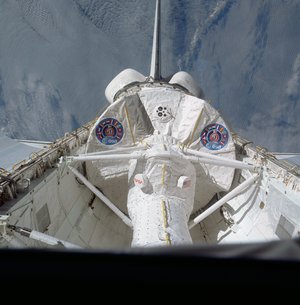Spacelab 1 factsheet
STS-9 (also known as STS-41A or Spacelab 1) was a United States Space Shuttle mission, the 6th mission of the Columbia orbiter. It was Columbia's last flight until early January of 1986 STS-61C.
It was also the last time the old Space Transportation System numbering was used until STS-26 (after STS-51-L, the mission which the Space Shuttle Challenger disaster happened).
MISSION STATISTICS
Mission name: STS-9
Shuttle: Columbia
Number of crew members: 6
Launch:
28 November 1983, 16:00:00 UTC
Landing:
8 December 1983, 23:47:23 UTC, Edwards AFB, Runway 17
Duration: 10 days, 7 hours, 47 minutes, 24 seconds
Number of orbits: 167
CREW
- John W. Young (6), Commander
- Brewster H. Shaw (1), Pilot
- Owen K. Garriott (2), Mission Specialist 1
- Robert A. Parker (1), Mission Specialist 2
- Ulf Merbold (1), Payload Specialist 1, ESA Germany
- Byron K. Lichtenberg (1), Payload Specialist 2
Backup payload specialists
- Alternate Payload Specialist: Wubbo Ockels
- Alternate Payload Specialist: Michael Lampton
(1) number of spaceflights each crew member has completed, including this mission

MISSION HIGHLIGHTS
Mission objective
For the STS-9 mission Columbia was once again back in orbit. The launch occurred at 11 a.m. EST, 28 November 1983, after a 1-month delay because of a nozzle problem with one of the SRBs. This necessitated moving the vehicle back to the Vehicle Assembly Building where the nozzle was replaced.
The 6-member crew—a manned space flight record at the time—included John W. Young, commander, on his second Shuttle flight; Brewster H. Shaw, pilot; Owen Garriott and Robert A. Parker, both mission specialists; and Byron K. Lichtenberg and Ulf Merbold payload specialists—the first two non-astronauts to fly on the Shuttle. Merbold, a citizen of West Germany, also was the first foreign citizen to participate in a Shuttle flight. Lichtenberg was a researcher at Massachusetts Institute of Technology.
The mission was devoted entirely to Spacelab l, a joint NASA/European Space Agency (ESA) program designed to demonstrate the ability to conduct advanced scientific research in space, with astronauts and payload specialists working in the Spacelab module and coordinating their efforts with scientists at the Marshall Payload Operations Control Center (POCC) then located at the Johnson Space Center. Funding for Spacelab l was provided by ESA.
The crew was divided into two teams, each working 12-hour shifts for the duration of the mission. Young, Parker and Merbold formed the Red Team, while Shaw, Garriott and Lichtenberg made up the Blue Team. Usually, the commander and the pilot team members were assigned to the flight deck, while the mission and payload specialists worked inside the Spacelab. Seventy-two scientific experiments were carried out in the fields of atmospheric and plasma physics, astronomy, solar physics, material sciences, technology, life sciences and Earth observations. The effort went so well that the mission was extended an additional day to 10 days, making it the longest duration Shuttle flight to that date.
The Spacelab l mission was highly successful, having proved the feasibility of the concept of carrying out complex experiments in space using non-NASA persons trained as payload specialists in collaboration with a POCC. Moreover, the Tracking and Data Relay Satellite, now fully operational, was able to relay vasts amounts of data through its ground terminal to the POCC.
Computer problems
During orbiter orientation, four hours before re-entry, one of the GPC guidance computers crashed when the RCS thrusters were fired. A few minutes later, a second crashed in a similar fashion, but was successfully rebooted.
Young delayed the landing, letting the orbiter drift. He later testified: "Had we then activated the Backup Flight Software, loss of vehicle and crew would have resulted." Post-flight analysis revealed the GPCs failed when the RCS thruster motion knocked a piece of solder loose and shorted out the CPU board.
Columbia landed on Runway 17 at Edwards AFB, on 8 December 1983, at 3:47 p.m. PST, completing 166 orbits and traveling 4.3 million miles. Right before landing, two of the orbiter's three auxiliary power units caught fire due to a hydrazine leak, but the orbiter still landed successfully. Columbia was ferried back to KSC on 15 December 1983. The leak was later discovered after it burned itself out and caused major damage to the compartment.















 Germany
Germany
 Austria
Austria
 Belgium
Belgium
 Denmark
Denmark
 Spain
Spain
 Estonia
Estonia
 Finland
Finland
 France
France
 Greece
Greece
 Hungary
Hungary
 Ireland
Ireland
 Italy
Italy
 Luxembourg
Luxembourg
 Norway
Norway
 The Netherlands
The Netherlands
 Poland
Poland
 Portugal
Portugal
 Czechia
Czechia
 Romania
Romania
 United Kingdom
United Kingdom
 Slovenia
Slovenia
 Sweden
Sweden
 Switzerland
Switzerland




























